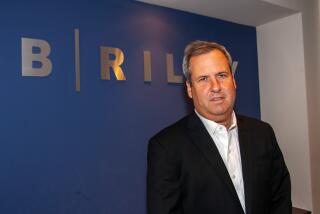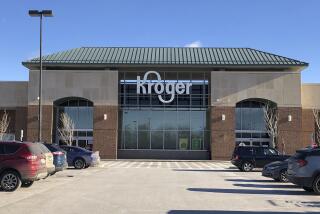Kohlberg Kravis Doing Deals Again : The Leveraged Buyout King of ‘80s Is Sifting Through Distressed Firms
NEW YORK — Just when you thought the ‘80s were over--gone, dead, buried--look who’s back, doing deals and garnering headlines.
It’s Kohlberg Kravis Roberts & Co., the gilded buyout firm whose $32-billion takeover of RJR Nabisco in 1989 capped off, and came to symbolize, a decade in which “greed is good” became a business mantra.
This time around the script is different. The prey is smaller and, at least in the two deals KKR did this week, consists of the shattered remains of that decade of excess.
On Monday, KKR teamed with Fleet/Norstar Financial Group to win an auction to buy the failed Bank of New England from the FDIC. KKR provided $283 million to back the winning $625-million bid and got a stake that is convertible into a 16.5% interest in Fleet.
On Thursday, KKR’s K-III Holdings Inc. partnership reached an understanding to buy nine publications from debt-burdened Rupert Murdoch for more than $600 million. Murdoch had been under orders from his bankers to sell assets and raise cash.
“When there is a compulsion to sell, those who can write the check can get themselves a good deal,” observed Michael E. Tennenbaum, vice chairman of investment banking for Bear, Stearns & Co. in Los Angeles. “KKR is taking advantage of opportunities arising from the over-leveraging of the ‘80s.”
Some readers of financial tea leaves see in KKR’s two deals the glimmers of a recovery in the long-moribund mergers-and-acquisitions business.
“We’re in the pupa, or caterpillar, stage of a recovery,” said Fredric M. Roberts, head of the Los Angeles corporate finance firm of F. M. Roberts & Co. “We’re not going to see fluttering butterflies for a while.”
Roberts said two kinds of deals make sense in the current market: “opportunistic” transactions, such as those done by KKR, and “strategic” deals, such as Office Depot’s purchase of Office Club in April.
KKR, which invests money for about 70 institutional clients, declined to comment for this story. But in a recent report prepared for investors, the firm sketched out some of its new investment strategies for the 1990s, strategies that no longer rely on the huge leveraged buyouts that brought such attention to the firm in the 1980s.
“We expect to see fewer very large deals in the future,” KKR said. “LBOs of $1 billion or less will be the order of the day, just as they were before publicly issued high-yield bonds became common.”
In addition, KKR said it would consider such new investment vehicles as creating companies from scratch by acquiring several businesses in a related industry, taking minority stakes in companies and investing in financial institutions to take advantage of the restructuring of the banking industry.
In retrospect, KKR couldn’t have drawn a better road map to this week’s deals. Both were for less than $1 billion. The Fleet-Bank of New England transaction fits two of the criteria that the firm sketched out by giving KKR a minority stake in a big financial institution.
And the Murdoch magazines will be folded into K-III Holdings, a publishing company that KKR has been building from scratch by acquiring such disparate assets as Funk & Wagnalls encyclopedias, the Astronomy Book Club, the Weekly Reader and National Hog Farmer magazine.
William F. Reilly, the former Macmillan Inc. president who is running K-III for KKR, calls his company “a leveraged buildup.” K-III, which is 75% funded by KKR, expected 1991 revenue of $500 million even before the Murdoch deal.
KKR isn’t only spending money. Not long ago, with only $1.6 billion in cash remaining in the $5.6-billion investment fund that it opened in 1987, the firm set out to raise another $1 billion to $2 billion from institutional investors such as pension funds. About $1.3 billion in private placements has already rolled in.
Just this month, KKR also orchestrated public offerings of many of the companies that it took private during the ‘80s, including RJR Nabisco, Safeway Stores and AutoZone.
Another company in KKR’s portfolio, Duracell, plans to sell 20 million shares at $12 to $14 a share. (KKR’s investors paid $5 a share in 1988.)
Proceeds from the public offerings went to the companies; neither KKR nor its investors sold any of their shares in the offerings, though all are sitting on hefty paper profits.
Although two highly leveraged KKR deals have gone bad--Hillsborough Holdings plunged into Chapter 11 bankruptcy proceedings in December, 1989, and Seaman Furniture had to restructure its debt--KKR retains perhaps the best track record in putting together profitable LBOs.
“Henry Kravis has negotiated the shoals very well,” said Tennenbaum, who calls himself “a respectful observer” of the man who runs KKR with George Roberts. “These latest acquisitions (of debt-plagued companies) are simply a continued economic response by an intelligent man. . . . You are going to see more of these things.”
KKR RETURNS TO THE SPOTLIGHT After a year on the sidelines, KKR this week made two major investments: * Monday: Investor group led by KKR agreed to buy $283 million of Fleet/Norstar Financial Group preferred stock, allowing Fleet to win FDIC auction for the failed Bank of New England. * Thursday: K-III Holdings, a partnership formed by KKR, reaches understanding to acquire nine publications from Rupert Murdoch’s cash-strapped News Corp. for more than $600 million. KKR also has been selling equity stakes to the public in some previous investments:
Number Price Original cost Date of of Shares per share per share to offering Company in offering in offering KKR investors 4/1/91 AutoZone 3.25 million $23.00 $2.50 4/1/91 RJR Nabisco 100 million $11.25 $5.00 4/9/91 Safeway Stores 17.5 million $20.50 $2.00
KKR’S BIGGEST DEALS 1. RJR Nabisco Inc.
Year: 1989
Purchase and financing: $32 billion
2. Beatrice Cos.
Year: 1986
Purchase and financing: $8.2 billion
3. Safeway Stores Inc.
Year: 1986
Purchase and financing: $5.2 billion
4. Owens-Illinois Inc.
Year: 1987
Purchase and financing: $4.4 billion
5. Hillsborough Holdings
Year: 1987
Purchase and financing: $3.3 billion
More to Read
Inside the business of entertainment
The Wide Shot brings you news, analysis and insights on everything from streaming wars to production — and what it all means for the future.
You may occasionally receive promotional content from the Los Angeles Times.










